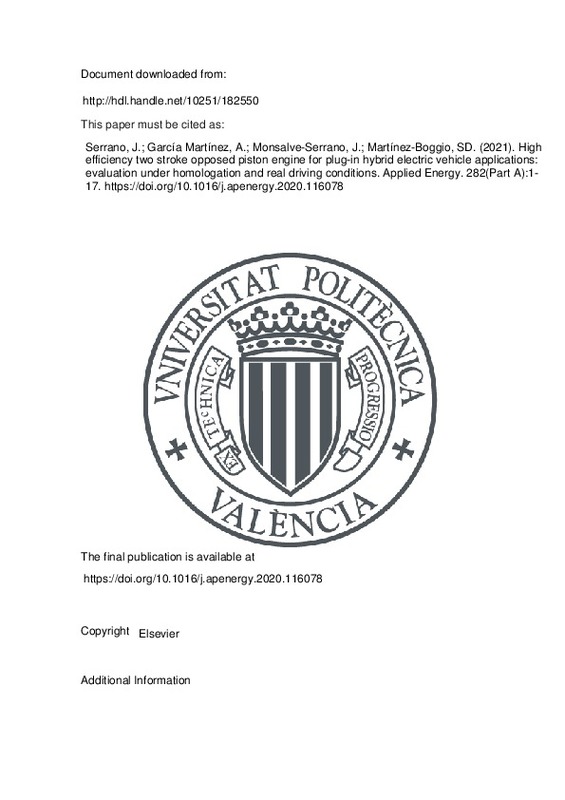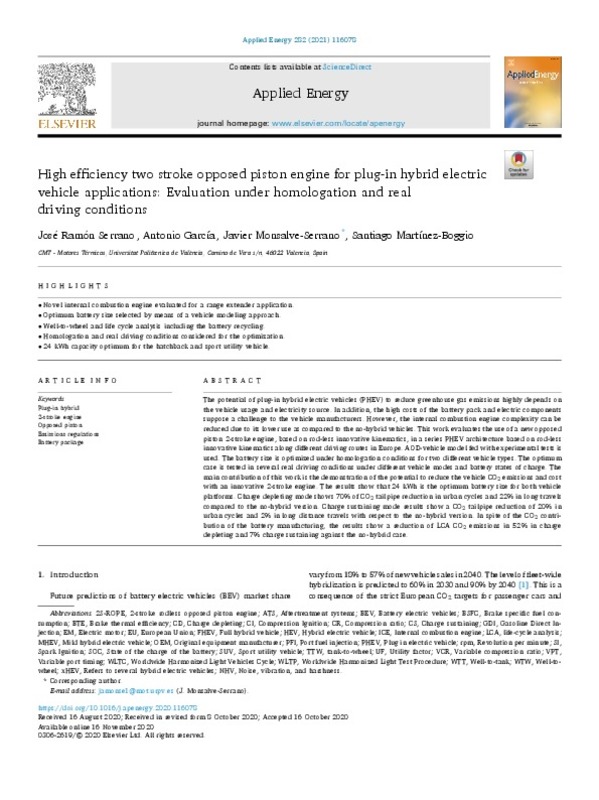JavaScript is disabled for your browser. Some features of this site may not work without it.
Buscar en RiuNet
Listar
Mi cuenta
Estadísticas
Ayuda RiuNet
Admin. UPV
High efficiency two stroke opposed piston engine for plug-in hybrid electric vehicle applications: evaluation under homologation and real driving conditions
Mostrar el registro sencillo del ítem
Ficheros en el ítem
| dc.contributor.author | Serrano, J.R.
|
es_ES |
| dc.contributor.author | García Martínez, Antonio
|
es_ES |
| dc.contributor.author | Monsalve-Serrano, Javier
|
es_ES |
| dc.contributor.author | Martínez-Boggio, Santiago Daniel
|
es_ES |
| dc.date.accessioned | 2022-05-11T18:06:30Z | |
| dc.date.available | 2022-05-11T18:06:30Z | |
| dc.date.issued | 2021-01-15 | es_ES |
| dc.identifier.issn | 0306-2619 | es_ES |
| dc.identifier.uri | http://hdl.handle.net/10251/182550 | |
| dc.description.abstract | [EN] The potential of plug-in hybrid electric vehicles (PHEV) to reduce greenhouse gas emissions highly depends on the vehicle usage and electricity source. In addition, the high costs of the battery pack and electric components suppose a challenge to the vehicle manufacturers. However, the internal combustion engine complexity can be reduced due to its lower use as compared to the no-hybrid vehicles. This work evaluates the use of a new opposed piston 2-stroke engine, based on rod-less innovative kinematics, in a series PHEV architecture based on rod-less innovative kinematics along different driving routes in Europe. A 0D-vehicle model fed with experimental tests is used. The battery size is optimized under homologation conditions for two different vehicle types. The optimum case is tested in several real driving conditions under different vehicle modes and battery states of charge. The main contribution of this work is the demonstration of the potential to reduce the vehicle CO2 emissions and cost with an innovative 2-stroke engine. The results show that 24 kWh is the optimum battery size for both vehicle platforms. Charge depleting mode shows 70% of CO2 tailpipe reduction in urban cycles and 22% in long travels compared to the no-hybrid version. Charge sustaining mode results show a CO2 tailpipe reduction of 20% in urban cycles and 2% in long distance travels with respect to the no-hybrid version. In spite of the CO2 contribution of the battery manufacturing, the results show a reduction of LCA CO2 emissions in 52% in charge depleting and 7% charge sustaining against the no-hybrid case. | es_ES |
| dc.description.sponsorship | This work has been partially supported by "Conselleria de Innovacion, Universidades, Ciencia y Sociedad Digital de la Generalitat Valenciana" through grant number GV/2020/017. The authors acknowledge FEDER and Spanish Ministerio de Economia y Competitividad for partially supporting this research through TRANCO project (TRA2017-87694-R). The authors want to thank INNengine for providing the engine and the help in the experimental campaign. Lastly, acknowledge to Gamma Technologies for the numerical simulation support and provide the GT-RealDrive licenses | es_ES |
| dc.language | Inglés | es_ES |
| dc.publisher | Elsevier | es_ES |
| dc.relation.ispartof | Applied Energy | es_ES |
| dc.rights | Reconocimiento - No comercial - Sin obra derivada (by-nc-nd) | es_ES |
| dc.subject | Plug-in hybrid | es_ES |
| dc.subject | 2-stroke engine | es_ES |
| dc.subject | Opposed piston | es_ES |
| dc.subject | Emissions regulations | es_ES |
| dc.subject | Battery package | es_ES |
| dc.subject.classification | MAQUINAS Y MOTORES TERMICOS | es_ES |
| dc.title | High efficiency two stroke opposed piston engine for plug-in hybrid electric vehicle applications: evaluation under homologation and real driving conditions | es_ES |
| dc.type | Artículo | es_ES |
| dc.identifier.doi | 10.1016/j.apenergy.2020.116078 | es_ES |
| dc.relation.projectID | info:eu-repo/grantAgreement/AEI/Plan Estatal de Investigación Científica y Técnica y de Innovación 2013-2016/TRA2017-87694-R/ES/REDUCCION DE CO2 EN EL TRANSPORTE MEDIANTE LA INYECCION DIRECTA DUAL-FUEL DE BIOCOMBUSTIBLES DE SEGUNDA GENERACION/ | es_ES |
| dc.relation.projectID | info:eu-repo/grantAgreement/GVA//GV%2F2020%2F017 / | es_ES |
| dc.relation.projectID | info:eu-repo/grantAgreement/GENERALITAT VALENCIANA//GV%2F2020%2F062//POTENCIAL DEL USO DE E-FUELS EN PLANTAS PROPULSIVAS HIBRIDAS COMO VIA DE REDUCCION DE LAS EMISIONES DE CO2 DEL SECTOR TRANSPORTE/ | es_ES |
| dc.rights.accessRights | Abierto | es_ES |
| dc.contributor.affiliation | Universitat Politècnica de València. Departamento de Máquinas y Motores Térmicos - Departament de Màquines i Motors Tèrmics | es_ES |
| dc.description.bibliographicCitation | Serrano, J.; García Martínez, A.; Monsalve-Serrano, J.; Martínez-Boggio, SD. (2021). High efficiency two stroke opposed piston engine for plug-in hybrid electric vehicle applications: evaluation under homologation and real driving conditions. Applied Energy. 282(Part A):1-17. https://doi.org/10.1016/j.apenergy.2020.116078 | es_ES |
| dc.description.accrualMethod | S | es_ES |
| dc.relation.publisherversion | https://doi.org/10.1016/j.apenergy.2020.116078 | es_ES |
| dc.description.upvformatpinicio | 1 | es_ES |
| dc.description.upvformatpfin | 17 | es_ES |
| dc.type.version | info:eu-repo/semantics/publishedVersion | es_ES |
| dc.description.volume | 282 | es_ES |
| dc.description.issue | Part A | es_ES |
| dc.relation.pasarela | S\421842 | es_ES |
| dc.contributor.funder | GENERALITAT VALENCIANA | es_ES |
| dc.contributor.funder | AGENCIA ESTATAL DE INVESTIGACION | es_ES |









